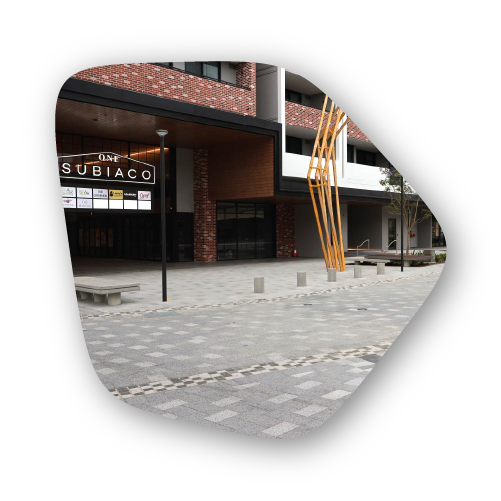
THE BONITA STONE BLOG:
Protect Your Investment: Why Paver Maintenance Matters More Than You Think
You’ve spent months planning your outdoor space — carefully choosing the right pavers, the perfect layout, and a design tahat reflects the quality of your brand or project. But here’s the truth few people talk about: even the most premium pavers can fade, crack, or shift if they’re not cared for properly. In the commercial world, where first impressions and longevity matter, neglected paving can turn a polished courtyard or walkway into an expensive liability. Crumbling edges, uneven surfaces, or dull, faded colours don’t just hurt the look of your space — they can pose safety risks, require costly repairs, and ultimately undermine your project’s value. Let’s dive into what really causes pavers to deteriorate — and how smart maintenance can help you protect your investment for decades.
The Hidden Enemies of Pavers: What You’re Up Against
Commercial paving projects face unique pressures compared to residential settings. High traffic, vehicle loads, weather extremes, and poor installation practices can all speed up the ageing process. Understanding these threats is the first step in prevention.
1. UV Exposure and Colour Fading
Australia’s harsh sun doesn’t just warm patios — it bleaches them. Without UV protection, the vibrant tones of brick, stone, or concrete pavers can fade unevenly, leaving a dull, patchy appearance. Once fading sets in, it’s irreversible without replacement or resurfacing.
2. Water Damage and Cracking
Moisture is one of the biggest culprits behind cracked and crumbling pavers. When water seeps beneath the surface, it can erode the bedding sand and base layer. During temperature changes, trapped water expands, creating cracks or surface flaking. Over time, this weakens the structural integrity of the entire paved area.
3. Soil Movement and Shifting
Even perfectly laid pavers can shift if the sub-base isn’t properly compacted or if drainage is inadequate. In commercial environments — car parks, courtyards, loading zones — constant pressure amplifies this issue. The result? Uneven, unstable surfaces that can quickly become safety hazards.
4. Chemical and Oil Stains
Spills from vehicles, cleaning products, or construction materials can stain pavers permanently. Some chemicals even react with concrete and sealant, accelerating surface breakdown.
How to Prevent Paver Fading, Cracking, and Shifting
The good news? These issues are completely avoidable with a proactive approach. A few smart habits and professional-grade solutions can dramatically extend the life and look of your paved surfaces.
How to Prevent Paver Fading, Cracking, and Shifting
The good news? These issues are completely avoidable with a proactive approach. A few smart habits and professional-grade solutions can dramatically extend the life and look of your paved surfaces.
1. Seal Your Pavers — and Re-Seal Regularly
A high-quality sealant acts like sunscreen and armour in one. It protects against UV rays, stains, and moisture penetration. For commercial projects, sealing should be considered a non-negotiable.
- When to Seal Pavers: Ideally, within 6–12 months of installation, once the pavers have settled.
- How Often: Every 2–3 years, or sooner if exposed to heavy traffic or harsh weather.
- Pro Tip: Use a breathable sealer designed for your specific paver type — not all sealants are equal.
2. Ensure Proper Drainage from Day One
Poor drainage is one of the most common causes of shifting and cracking. Make sure your site has:
- A well-compacted base layer
- Slight grading for water runoff
- Adequate drainage channels or soak wells
If water pools on your surface after rain, it’s a sign you need to act fast. Left unchecked, it can cause erosion beneath the surface and loosen the entire structure.
3. Don’t Skimp on the Base and Bedding Layers
Even the most durable pavers are only as strong as what’s beneath them. A solid foundation requires:
- A compacted crushed rock sub-base
- Evenly spread bedding sand
- Tight edge restraints to prevent movement
For large commercial projects, it’s worth investing in professional installation with laser-levelling and mechanical compaction to ensure a long-lasting result.
4. Clean and Maintain Regularly
Routine cleaning might seem cosmetic, but it’s a powerful way to prevent damage. Dirt, organic debris, and chemical residue can eat away at sealant and trap moisture.
- Use a pressure washer on a low setting to avoid dislodging joint sand.
- Remove weeds and moss early before roots spread.
- Reapply joint sand annually to maintain structural stability.
5. Address Damage Immediately
Tiny cracks or lifted pavers might not seem urgent — until they spread. Regular inspections help you spot issues early. Replacing a few damaged pavers or re-levelling a small section is far more cost-effective than a full surface replacement.
Warning Signs You Shouldn’t Ignore
If you notice any of these early indicators, it’s time to act:
- Uneven surfaces or pooling water after rain
- Loose or rocking pavers when walked on
- Faded patches or surface chalkiness
- Efflorescence (white powdery residue) indicating trapped moisture
- Weeds or moss growth between joints
Each of these signs points to underlying issues — most of which get exponentially worse (and more expensive) over time.
The Cost of Neglect: A Price No Project Manager Wants to Pay
Skipping maintenance might save you in the short term, but over time it leads to:
- Higher replacement and labour costs
- Safety hazards and liability risks
- Project downtime during repairs
- Diminished property value and brand presentation
Commercial clients and property owners expect durability and reliability. Failing to maintain pavers can quickly become a reputational issue — one that’s easily avoided with consistent care.
Keep It Strong, Keep It Stunning: Best Practices for Long-Term Performance
Maintaining your paved spaces doesn’t have to be a burden. By following a few professional habits, you can ensure they stay as flawless as the day they were installed:
- Schedule professional maintenance inspections annually.
- Re-seal regularly to protect against UV, moisture, and stains.
- Keep surfaces clean with gentle washing and joint sand refilling.
- Repair early — don’t wait for damage to spread.
- Invest in quality materials and expert installation from the start.
When done right, these practices can double or even triple the lifespan of your pavers — preserving not just their look, but their safety and performance.
Final Thoughts: Prevention is Profit
In commercial and large-scale projects, prevention isn’t just maintenance — it’s profit protection. Faded, cracked, or shifting pavers can damage your brand image and lead to unnecessary costs. But with a little foresight, the right materials, and a proactive maintenance plan, your paved spaces can stay beautiful, durable, and low-maintenance for years to come.
Don’t let your investment crumble beneath your feet — protect it before the damage starts.
Contact Bonita Stone Today for help protecting your paving investment today.
STRUGGLING TO CHOOSE THE RIGHT PAVERS?
Our experts at Bonita Stone can guide you every step of the way. Get a free quote and professional advice today.
GET YOUR FREE QUOTE





